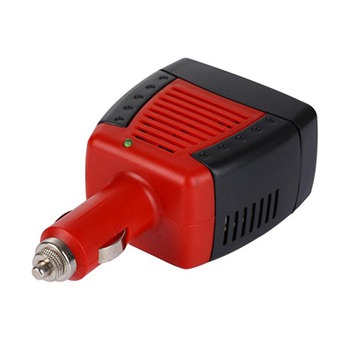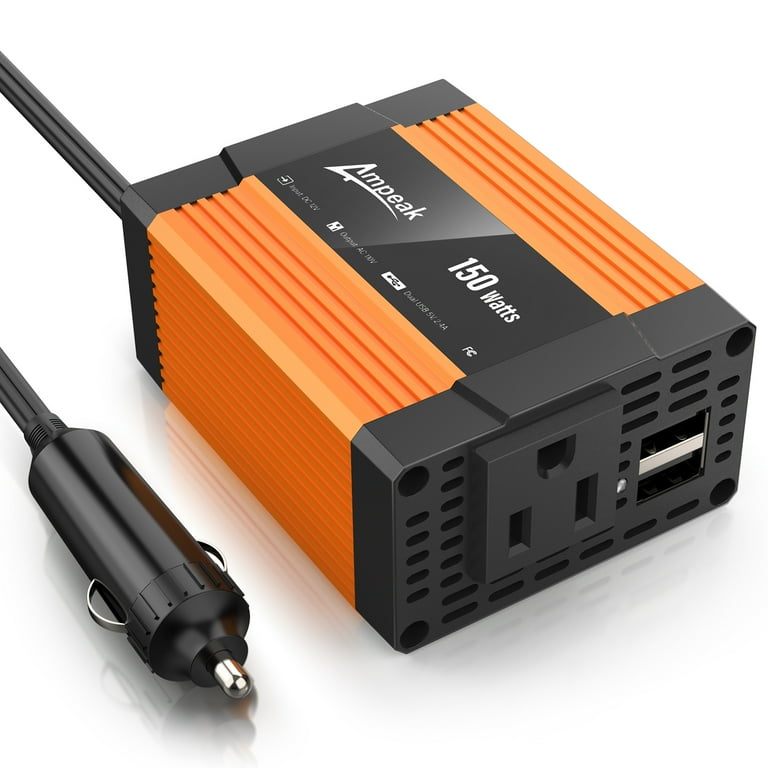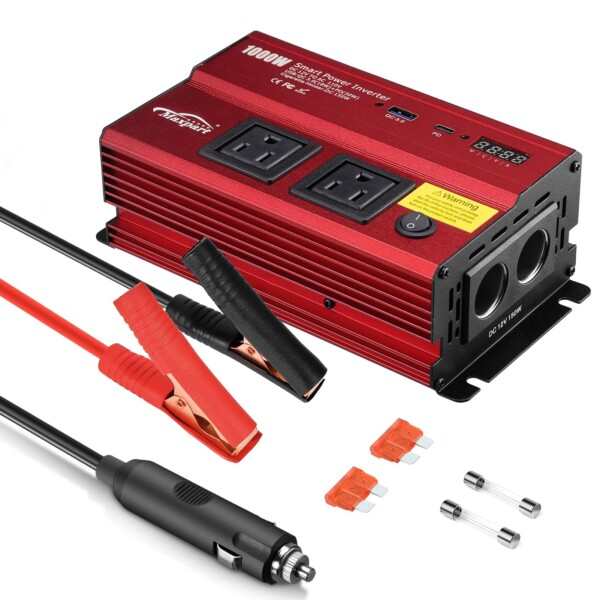Car power inverters are generally safe when used correctly. Always follow the manufacturer’s guidelines and safety instructions.
Car power inverters convert your vehicle’s DC power to AC power, allowing you to use household devices on the go. These devices are particularly useful for road trips, camping, and working remotely. Proper usage ensures safety and efficiency. Always check the power rating of your inverter and match it with your devices.
Avoid overloading the inverter to prevent overheating and potential hazards. Ensure good ventilation around the inverter to avoid overheating. Using quality inverters from reputable brands reduces risks. Regularly inspect cables and connections for wear and tear. By following these precautions, you can safely enjoy the convenience of car power inverters.

Credit: www.inverter.com
Introduction To Car Power Inverters
Car power inverters are valuable devices for modern drivers. They convert DC power from your car battery to AC power. This lets you use standard household devices on the go.
What Are Car Power Inverters?
Car power inverters are electronic devices. They change the car’s 12V DC power to 110V AC power. This is the standard power used in homes. The inverter connects to the car’s battery. It provides a way to power devices like laptops, TVs, and small appliances.
There are different types of inverters. Pure sine wave inverters produce power similar to home outlets. Modified sine wave inverters are cheaper but less efficient. They may not work with all devices.
| Type | Cost | Efficiency |
|---|---|---|
| Pure Sine Wave | Higher | High |
| Modified Sine Wave | Lower | Medium |
Common Uses
Car power inverters have many uses. They are helpful for road trips. You can charge laptops, phones, and cameras. They are also useful for camping. You can power small appliances like coffee makers and fans.
- Charging electronic devices
- Powering small appliances
- Running medical equipment
- Providing power during emergencies
Emergency situations often need power. A car power inverter can run medical devices. It can also charge emergency lights and radios.
How Car Power Inverters Work
Understanding how car power inverters work can help you use them safely. They are essential devices for converting DC power from your car battery to AC power. This lets you run household appliances using your car’s electrical system.
Basic Mechanism
Car power inverters take the 12V DC from your car battery and convert it to 110V AC. This allows you to use devices like laptops, chargers, and small appliances.
The conversion process involves several key components:
- Transformer: Steps up the voltage from 12V to 110V.
- Oscillator: Creates an AC signal from the DC input.
- Rectifier: Converts the AC signal back to DC for internal use.
- Inverter Circuit: Converts the DC back to a stable AC output.
Types Of Inverters
There are two main types of car power inverters:
| Type | Description |
|---|---|
| Modified Sine Wave Inverters | These are affordable and work for most devices. They produce a square wave that approximates a sine wave. |
| Pure Sine Wave Inverters | These produce a smooth sine wave, just like household power. They are more expensive but better for sensitive electronics. |
Choosing the right type depends on your needs. For basic use, a modified sine wave inverter is sufficient. For sensitive electronics, a pure sine wave inverter is recommended.
Potential Risks
Car power inverters offer great convenience. But they come with some risks. Understanding these risks is crucial for safe usage. Below we explore some potential hazards. This includes electrical hazards and battery drain.
Electrical Hazards
Power inverters can pose electrical hazards. They convert DC to AC power. This process can create sparks. Sparks can lead to fires. Always use inverters with proper insulation. Avoid exposing them to moisture. Wet conditions increase the risk of electrical shock. Ensure all connections are secure. Loose connections can cause short circuits. Short circuits can damage your car’s electrical system.
Battery Drain
Using a car power inverter can drain your battery. Especially if the engine is off. Inverters draw power from the car battery. Prolonged use can deplete the battery. This might leave you stranded. To avoid this, monitor usage time. Limit the power drawn by connected devices. Disconnect the inverter when not in use. Check the battery’s health regularly. A healthy battery supports better inverter performance.
| Hazard | Risk | Prevention |
|---|---|---|
| Electrical Shock | High | Use proper insulation |
| Fire | Medium | Avoid moisture exposure |
| Battery Drain | High | Monitor usage time |
- Secure all connections to prevent short circuits.
- Use in dry conditions to avoid shocks.
- Disconnect when not in use to save battery.
- Ensure proper insulation on all connections.
- Check battery health regularly.
- Monitor the power drawn by devices.

Credit: www.amazon.com
Safety Features
Car power inverters are essential for powering electronics on the go. Safety is crucial for these devices. Modern inverters come with multiple safety features. These features protect both the device and the user. Let’s dive into some key safety features.
Overload Protection
Overload protection is vital for car power inverters. This feature prevents the device from being damaged. Overload protection kicks in if the load exceeds the inverter’s capacity. It automatically shuts down the device. This protects both the inverter and the connected electronics.
Temperature Control
Temperature control is another important feature. Inverters can get hot during use. Temperature control keeps the device at a safe temperature. It uses internal sensors to monitor heat levels. If the temperature rises too high, the inverter cools itself down. This prevents overheating and potential damage.
| Safety Feature | Function |
|---|---|
| Overload Protection | Automatically shuts down to prevent overload damage |
| Temperature Control | Keeps the inverter at a safe temperature to avoid overheating |
Modern car power inverters are designed with user safety in mind. These features ensure the longevity of your device. They also protect your electronics from damage. When buying an inverter, check for these safety features. They are essential for safe and reliable performance.
| You May Like: Clean And Maintain a Bestek Inverter?
Installation Tips
Installing a car power inverter can be easy if done right. Follow these tips to ensure a safe and efficient setup.
Choosing The Right Inverter
Choosing the right inverter is crucial. Ensure the inverter matches your power needs. Check the wattage requirements of your devices. Select an inverter that provides more watts than you need. This ensures you don’t overload the system.
Look for inverters with built-in safety features. These include overload protection, short circuit protection, and low battery shutdown. These features help prevent damage and ensure safety.
Proper Wiring
Proper wiring is essential for safety and performance. Use the right gauge of wire for your inverter. Thicker wires handle more current and reduce heat. Always follow the manufacturer’s wiring recommendations.
| Inverter Wattage | Recommended Wire Gauge |
|---|---|
| Up to 300W | 16 AWG |
| 300W – 500W | 14 AWG |
| 500W – 1000W | 12 AWG |
| 1000W – 1500W | 10 AWG |
Install a fuse or circuit breaker close to the battery. This protects against short circuits and overcurrent. Connect the positive wire to the positive terminal of the battery. Connect the negative wire to the car’s chassis or a grounding point.
Secure all connections tightly. Loose connections can cause sparks or heat. Double-check your work before turning on the inverter.
- Use insulated tools to avoid short circuits.
- Never touch bare wires when the system is live.
- Route wires away from moving parts and high heat.
Test the inverter by plugging in a small device. Ensure everything works correctly before using higher-wattage devices.

Credit: www.walmart.com
Maintenance Practices
Proper maintenance of car power inverters ensures their longevity and safe operation. Regular checks and cleaning can prevent common issues and hazards. Follow these simple steps to keep your power inverter in top condition.
Regular Inspections
Consistent inspections are crucial for the safety and efficiency of your power inverter. Here’s a simple checklist:
- Check connections: Ensure all cables and plugs are secure.
- Inspect for damage: Look for frayed wires or burnt components.
- Test functionality: Verify that the inverter powers your devices correctly.
Perform these inspections monthly to catch issues early.
Cleaning Tips
Keeping your power inverter clean helps prevent overheating and malfunction. Follow these cleaning tips:
- Turn off power: Always disconnect the inverter before cleaning.
- Use a soft cloth: Wipe the exterior with a damp cloth to remove dust.
- Compressed air: Use compressed air to clean vents and fans.
Avoid using harsh chemicals that could damage the inverter.
| Task | Frequency |
|---|---|
| Check connections | Monthly |
| Inspect for damage | Monthly |
| Test functionality | Monthly |
| Clean exterior | Quarterly |
| Clean vents and fans | Quarterly |
Following these simple maintenance practices ensures your car power inverter stays safe and efficient.
User Experiences
Many drivers use car power inverters. Their experiences vary widely. Some face issues, while others enjoy seamless performance. Let’s explore these experiences.
Common Issues
Many users report common issues with car power inverters. Here are some of the most frequent problems:
- Overheating: Power inverters can get very hot. This can cause discomfort and potential damage.
- Battery Drain: Some inverters drain the car battery quickly. This can leave users stranded.
- Noise: Certain models produce a humming sound. This can be annoying during long drives.
- Compatibility: Not all devices work with all inverters. This can limit their usefulness.
These issues can be frustrating. But they are often manageable with the right steps.
Success Stories
Despite the issues, many users have positive experiences. Here are some success stories:
- Long Road Trips: Users report smooth functioning on long trips. They can charge multiple devices without problems.
- Emergency Situations: Inverters help in emergencies. They power vital devices when needed most.
- Camping Adventures: Campers enjoy using inverters. They power lights, fans, and even small fridges.
These stories highlight the benefits of car power inverters. They prove that with careful use, inverters are quite safe and useful.
Frequently Asked Questions
Are Car Power Inverters Safe To Use?
Yes, car power inverters are generally safe. They convert DC to AC power. Ensure proper installation and follow manufacturer guidelines.
Can Car Inverters Damage The Battery?
Improper use can damage the battery. Use the inverter within its specified limits. Regularly check the battery’s health.
What Devices Can I Plug Into A Car Inverter?
You can plug in small electronics like laptops, phones, and chargers. Avoid high-power appliances like microwaves.
How Do I Choose A Safe Car Inverter?
Choose an inverter with the right wattage for your devices. Look for safety features like overload protection.
Conclusion
Car power inverters are generally safe with proper use. Always follow manufacturer guidelines for the best results. Ensure your devices are compatible and avoid overloading the inverter. Regular maintenance can enhance safety and performance. By taking these precautions, you can enjoy the benefits of a car power inverter without worries.

